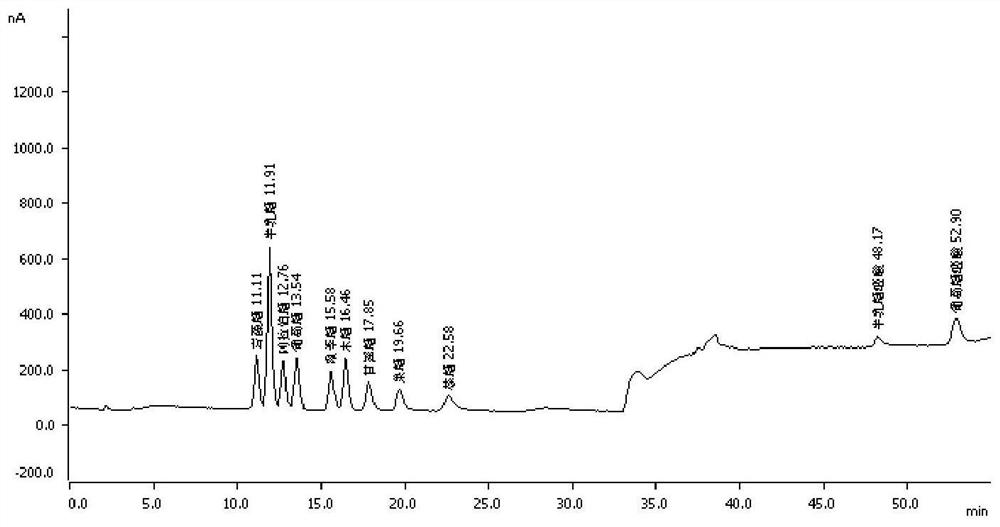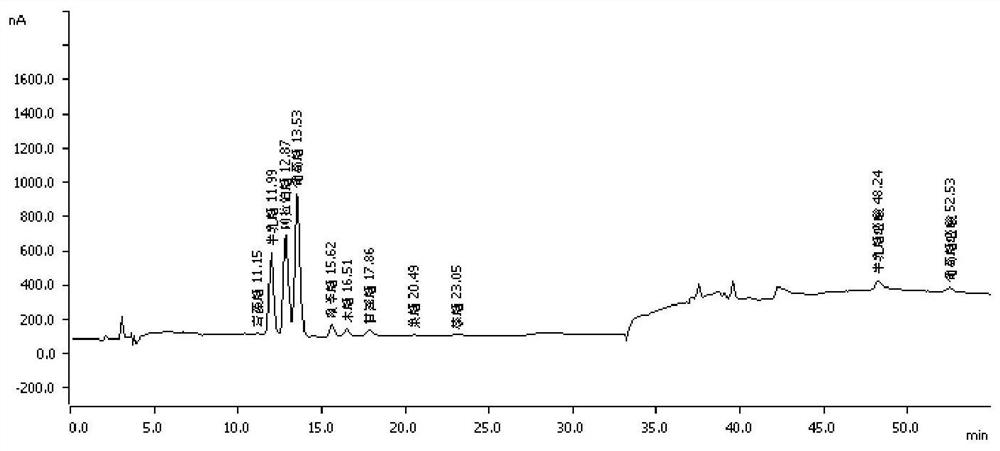Method for measuring content of plant polysaccharide
A plant polysaccharide and measurement method technology, applied in the detection field, can solve the problems of negative impact of the environment and experimenters, poor specificity, excessive addition of PMP, etc., and achieve the effect of shortening the hydrolysis time
- Summary
- Abstract
- Description
- Claims
- Application Information
AI Technical Summary
Problems solved by technology
Method used
Image
Examples
Embodiment 1
[0037] 1. Extraction of Lycium barbarum polysaccharide
[0038] Take the dried medlar, remove impurities such as fruit stalks and leaves, crush, mix well and set aside.
[0039] Accurately weigh (0.5 ± 0.05) g of sample powder, add 100 mL of ether, heat to reflux for 1 hour, let stand, let cool, carefully discard the ether solution, and place the residue on a water bath to evaporate the ether. Add 100mL of 80% ethanol, heat to reflux for 1 hour, filter while hot, wash the filter residue and filter with 30mL of hot 80% ethanol, put the filter residue and filter paper in a flask, add 150mL of water, and heat to reflux for 2 hours. Filter while hot, wash the filter with a small amount of hot water, combine the filtrate and lotion, and concentrate the solvent by rotary evaporation, then transfer to a 25mL volumetric flask, wash the rotary evaporator with a small amount of hot water, combine the concentrated solution and lotion, let cool, Dilute to the mark with water and shake we...
Embodiment 2
[0080] Embodiment 2: Determination of Lycium barbarum polysaccharide content in Lycium barbarum by the established method
[0081] Take 20 μL of the sample solution after microwave-assisted digestion, inject it into the ion chromatograph, analyze according to the above ion chromatographic conditions, and record the peak area. Qualitative according to the retention time of the reference substance, and quantitative by the external standard method. The content of each monosaccharide in the measured 3 batches of wolfberry actual samples is shown in Table 7:
[0082] Table 7 The mass concentration table of each monosaccharide component in the actual sample of Lycium barbarum (unit: μg / mL)
[0083]
[0084] According to the test results, the content of Lycium barbarum polysaccharide in three batches of Lycium barbarum samples was 2.24%, 2.28% and 2.56%, respectively.
[0085] 7. Standard recovery experiment
[0086] At the same time, the recovery rate of standard addition was ...
PUM
 Login to View More
Login to View More Abstract
Description
Claims
Application Information
 Login to View More
Login to View More - Generate Ideas
- Intellectual Property
- Life Sciences
- Materials
- Tech Scout
- Unparalleled Data Quality
- Higher Quality Content
- 60% Fewer Hallucinations
Browse by: Latest US Patents, China's latest patents, Technical Efficacy Thesaurus, Application Domain, Technology Topic, Popular Technical Reports.
© 2025 PatSnap. All rights reserved.Legal|Privacy policy|Modern Slavery Act Transparency Statement|Sitemap|About US| Contact US: help@patsnap.com



